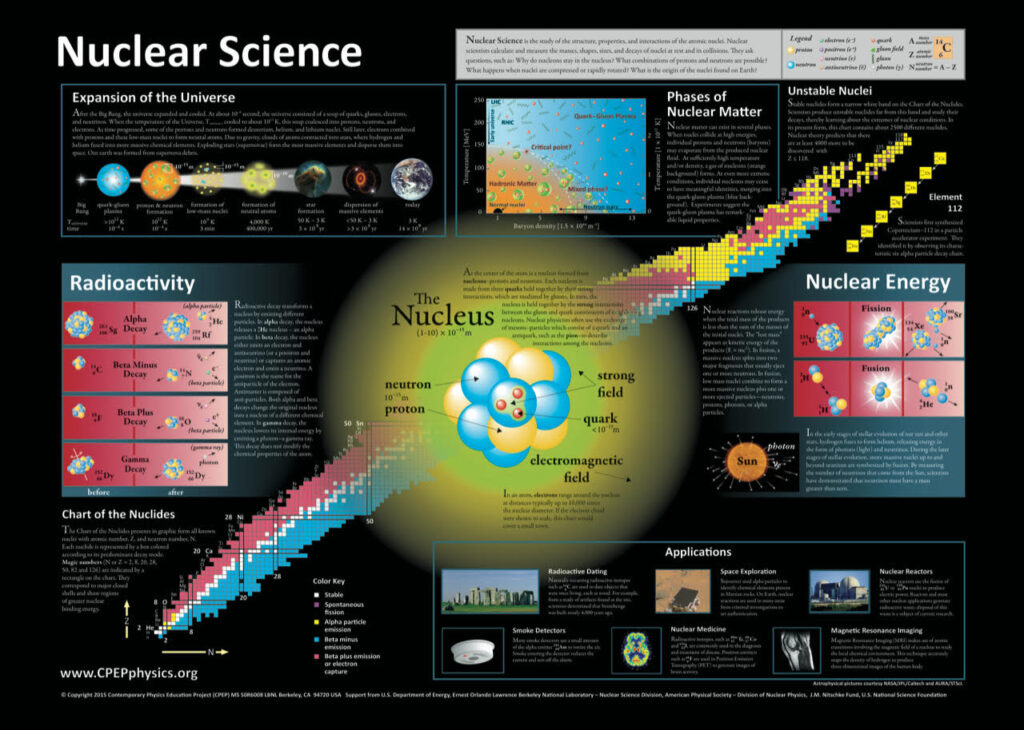Nuclear Science
Nuclear Chart
The colorful Nuclear Science Chart shows what are the parts of the nucleus, what are the heaviest elements, and how nuclear particles interact. It explains radioactive decay and the sources of nuclear energy. It examines nuclear matter that can only be made in the laboratory. It shows how matter evolved from the start of our Universe to present time. Finally, several examples of the applications of Nuclear Science are illustrated.
The chart includes results from nuclear interactions studied all over the world including the Large Hadron Collider at CERN, where the energy of the collisions are more than 100 times greater than those used to discover the Higgs boson. These results give us a glimpse at the Universe when it was many fractions of seconds old.

Created in conjunction with the Nuclear Science Wall Chart, this site a web version of A Teacher’s Guide to the Nuclear Science Wall Chart which is available on the web as PDF or on paper as a booklet.
Resources:
Teacher Resources:
Nuclear Teacher's Guide
Navigating Nuclear, American Nuclear Society
Virtual Field Trips, American Nuclear Society
Idaho National Laboratory (INL) k-12
The ABC's of Nuclear Science:
The ABC’s of Nuclear Science is a brief introduction to Nuclear Science. We look at Antimatter, Beta rays, Cosmic connection and much more. Visit here and learn about radioactivity – alpha, beta and gamma decay. Find out the difference between fission and fusion. Learn about the structure of the atomic nucleus. Learn how elements on the earth were produced. Do you know that you are being bombarded constantly by nuclear radiation from the Cosmos? Discover if there are radioactive products found in a grocery store. Do you know if you have ever eaten radioactive food? Find out what materials are needed to shield us from alpha, beta, gamma, radiation. Discover what have we gained by its study.
General Resources:
Phet on alpha decay
Study the concept of Alpha decay and Half-life by observing either a large group of unstable nuclei or a single nucleus. A standard emitter can be chosen or “create-your-own” by choosing the half-life. Observe either the amount of originals (parents) remaining compared to decay products (daughters) versus time or watch one nuclei to see how long it can last before decaying. Using variations, the meaning of half-life and that it is a statistical process can be shown.
Phet on beta decay
Study the concept of Beta decay and Half-life by observing either a large group of unstable nuclei or a single nucleus. Choose from two standard emitter or “create-your-own” by choosing the half-life. Observe either the amount of originals (parents) remaining compared to decay products (daughters) versus time or watch one nuclei to see how long it can last before decaying. Using variations, the meaning of half-life and that it is a statistical process can be shown.
Phet on radioactive dating and half-life
Multifaceted Phet starting with the concepts of half-life and decay rates. In the Measurement section, determine when measuring the amount of C-14 or U-238 decays is the right tool in determining the length of time since an organism has died or a volcanic rock has cooled. Prove your skills at mastering these concepts by playing the Radioactive Dating Game. Choose an object and use the given information to determine how much time has passed since the object was alive.
students grade 7-12. nuclear-science-educational-materials:
A wide spectrum of outreach programs, lesson plans and games targeted at age groups from K-12 to the general public. Teacher resources are also provided.
NASA Eclipse Website
Find NASA’s official resources for upcoming eclipses, including interactive maps, safety tips, and scientific data.
Video Resources:
Fission and Fusion
Compare nuclear fission and fusion, including how they work and their energy potential.
The Race to Nuclear Fusion Power
Follow the global race to develop practical nuclear fusion as a clean energy source.
Why some elements are radioactive
Learn the physics behind why certain atomic nuclei are unstable and emit radiation.
2 Billion Year Old Nuclear Reactor
Explore the naturally occurring nuclear fission reactor discovered in Gabon, Africa, that operated billions of years ago.
The Genius of Marie Curie
Discover the groundbreaking scientific achievements and personal struggles of Marie Curie.
A documentary on Marie Curie
Watch a full documentary on Marie Curie’s groundbreaking discoveries, personal hardships, and legacy as the first woman to win two Nobel Prizes.
Marie Curie's notebook
Find out why Marie Curie’s notebooks are still radioactive and what they reveal about early nuclear research.
Argonne Nuclear Pioneers
Meet the scientists at Argonne National Laboratory who developed early nuclear technologies.
Atoms for Peace: Promises, Dream and Explanations as told from over hald a century ago
Review historical footage and commentary on the “Atoms for Peace” program, promoting peaceful uses of nuclear energy.
Can Nuclear Propulsion take us to mars?
See how nuclear propulsion could revolutionize space travel by cutting transit time to Mars in half.
NASA's new space reactor is powered by Nuclear Fission
Learn about NASA’s compact fission reactor designed to provide long-term power for missions to the Moon and Mars.
How smoke detectors work
See how smoke detectors use small amounts of radioactive material to sense smoke and save lives.
Juno & NASA's Plutonium Shortage
Explore how NASA powers spacecraft like Juno with limited supplies of plutonium-238.
The problem of power in space. NASA's new Kilopower Reactor
Understand the challenges of generating electricity in space and the solutions under development.
How Nuclear power plants work
Explore how nuclear fission generates heat to produce electricity in modern power plants.
Breazeale Nuclear Reactor Start Up and Shut Down
Watch the startup and shutdown procedures of the Breazeale Nuclear Reactor, the oldest operating reactor in the U.S.
